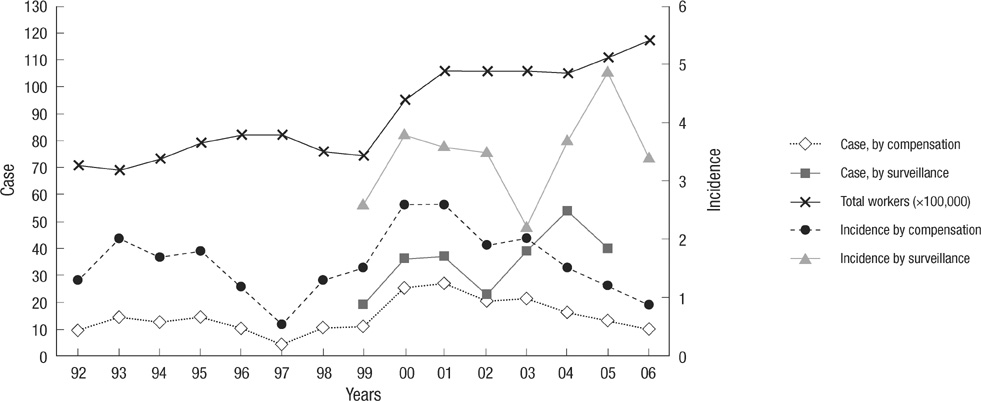J Korean Med Sci.
2010 Dec;25(Suppl):S20-S25. 10.3346/jkms.2010.25.S.S20.
Occupational Asthma in Korea
- Affiliations
-
- 1Department of Occupational & Environmental Medicine, Wonju Christian Hospital Wonju College of Medicine, Yonsei University, Wonju, Korea. oss0609@yonsei.ac.kr
- 2Occupational Safety and Health Research Institute, KOSHA, Incheon, Korea.
- KMID: 1714063
- DOI: http://doi.org/10.3346/jkms.2010.25.S.S20
Abstract
- Occupational asthma (OA) is the leading occupational respiratory disease. Cases compensated as OA by the Korea Workers' Compensation and Welfare Service (COMWEL) (218 cases), cases reported by a surveillance system (286 cases), case reports by related scientific journals and cases confirmed by the Occupational Safety and Health Research Institute (OSHRI) over 15 yr from 1992 to 2006 were analyzed. Annual mean incidence rate was 1.6 by compensation and 3.5 by surveillance system, respectively. The trend appeared to increase according to the surveillance system. Incidence was very low compared with other countries. The most frequently reported causative agent was isocyanate followed by reactive dye in dyeing factories. Other chemicals, metals and dust were also found as causative agents. OA was underreported according to compensation and surveillance system data. In conclusion, a more effective surveillance system is needed to evaluate OA causes and distribution, and to effectively prevent newly developing OA.
MeSH Terms
Figure
Reference
-
1. Bernstein IL, Chan-Yeung M, Malo JL, Bernstein DI. Bernstein IL, Chan-Yeung M, Malo JL, Bernstein DI, editors. Definition and classification of asthma. Asthma in the workplace. 1999. New York: Marcel Dekker Inc.;1–4.2. Meyer JD, Holt DL, Cherry NM, McDonald JC. SWORD'98: surveillance of work-related and occupational respiratory disease in the UK. Occup Med (Lond). 1999. 49:485–489.3. Bernstein DI, Bernstein IL. Middleton E, Reed CE, Ellis EF, Adkinson NF, Yunginger JW, Busse WW, editors. Occupational asthma. Allergy: Principles and Practice. 1999. 5th ed. St Louis: Mosby;963–980.4. Salvaggio J. Occupational and environmental respiratory disease, in NIAID task force report: Asthma and other allergic disease. 1979. Department of Health, Education and Welfare.5. Kobayashi S. Frazier C, editor. Different aspects of occupational asthma in Japan. Occupational asthma. 1980. New York: Van Nostrand Reinhold.6. Kogevinas M, Zock JP, Jarvis D, Kromhout H, Lillienberg L, Plana E, Radon K, Toren K, Alliksoo A, Benke G, Blanc PD, Dahlman-Hoglund A, D'Errico A, Héry M, Kennedy S, Kunzli N, Leynaert B, Mirabelli MC, Muniozguren N, Norback D, Olivieri M, Payo F, Villani S, van Sprundel M, Urrutia I, Wieslander G, Sunyer J, Antó JM. Exposure to substances in the workplace and new-onset asthma: an international prospective population-based study (ECRHS-II). Lancet. 2007. 370:336–341.7. Torén K, Blanc PD. Asthma caused by occupational exposure is common-a systematic analysis of estimates of the population-attributable fraction. BMC Pulm Med. 2009. 9:7.8. Chae CH, Choi SW, Choi YH, Jin YW, Kim EA, Kang SK. The work-related cases among bronchial asthma diagnosed at a university hospital in Incheon. Korean J Occup Environ Med. 1999. 11:174–180.9. Diller WF. Frequency and trends of occupational asthma due to toluene diisocyanate: a critical review. Appl Occup Environ Hyg. 2002. 17:872–877.10. Kang SK, Jee YK, Nahm DH, Min KU, Park JW, Park HS, Son CH, Cho SH, Choi I, Choi SW, Hong CS, Kim KS, Cho SH, Kim YY. A status of occupational asthma in Korea through the cases reported to the Occupational Asthma Surveillance Center. J Asthma Allergy Clin Immunol. 2000. 20:906–915.11. Orriols R, Costa R, Albanell M, Alberti C, Castejon J, Monso E, Panades R, Rubira N, Zock JP. Malaltia Ocupacional Respiratória (MOR) Group. Reported occupational respiratory diseases in Catalonia. Occup Environ Med. 2006. 63:255–260.12. Ameille J, Pauli G, Calastreng-Crinquand A, Vervloët D, Iwatsubo Y, Popin E, Bayeux-Dunglas MC, Kopferschmitt-Kubler MC. Observatoire National des Asthmes Professionnels. Reported incidence of occupational asthma in France, 1996-99: the ONAP programme. Occup Environ Med. 2003. 60:136–141.13. McDonald JC, Keynes HL, Meredith SK. Reported incidence of occupational asthma in the United Kingdom. 1989-97. Occup Environ Med. 2000. 57:823–829.14. Bernstein IL. Isocyanate induced pulmonary disease: a current perspective. J Allergy Clin Immunol. 1982. 70:24–31.15. Kim KS, Park JW, Hong CS, Kang SK. A case of reactive dye induced asthma in an exposed worker near a dye factory. Korean J Occup Environ Med. 2002. 14:326–333.16. Ministry of Employment and Labor. Work Environment Survey 2004. 2004. Gwacheon: Ministry of Employment and Labor.


